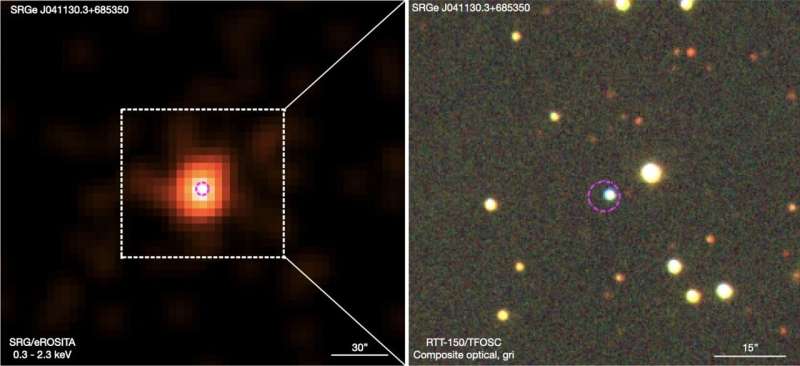January 16, 2024 report
This article has been reviewed according to Science X's editorial process and policies. Editors have highlighted the following attributes while ensuring the content's credibility:
fact-checked
peer-reviewed publication
trusted source
proofread
New cataclysmic variable discovered that may contain a brown dwarf secondary

An international team of astronomers reports the discovery of a new cataclysmic variable. The newfound system, designated SRGeJ041130.3+685350 (or SRGeJ0411 for short), has an orbital period of about 100 minutes and may contain a brown dwarf. The findings were detailed in a paper published January 4 in the Monthly Notices of the Royal Astronomical Society.
Cataclysmic variables (CVs) are binary star systems consisting of a white dwarf primary that is accreting matter from a normal star companion. They irregularly increase in brightness by a large factor, then drop back down to a quiescent state. These binaries have been found in many environments, such as the center of the Milky Way galaxy, the solar neighborhood, and within open and globular clusters.
Now, a group of astronomers led by Ilkham Galiullin of the Kazan Federal University in Russia, has discovered a new CV as part of a joint SRG/eROSITA and Zwicky Transient Facility (ZTF) program. This multi-wavelength campaign, combining X-ray and optical information, gives the possibility to search for and discover new systems of this type.
"In this paper, we present the study and characterization of the new eclipsing CV with evidence of a brown dwarf secondary, SRGeJ0411," the researchers wrote.
SRGeJ0411 was discovered in the SRG/eROSITA all-sky survey, and it was identified as a CV candidate through its high X-ray to optical flux ratio at a level of 0.6. Its optical spectrum showcases prominent hydrogen and helium emission lines, which is typical for cataclysmic variables.
The observation found that SRGeJ0411 has an X-ray luminosity of approximately 2.4 nonillion erg/s in the 0.3–2.3 keV energy band and its accretion rate is relatively low. The ZTF optical light curve shows deep eclipses of the system and provides no evidence of a significant outburst.
According to the study, SRGeJ0411 is located at a distance of about 1,056 light years and has an orbital period of 97.53 minutes. The white dwarf in the system is only one percent of the sun's size, while its mass is estimated to be 0.84 solar masses. The white dwarf's temperature was measured to be 13,790 K.
When it comes to the donor in SRGeJ0411, the authors of the paper assume that it is a brown dwarf. The object has a radius of less than 0.11 solar radii, mass lower than 0.04 solar masses, and its temperature is estimated to be less than 1,800 K.
The researchers explain that the parameters of SRGeJ0411 suggest that it is a new "period bouncer." The so-called period bouncers are highly-evolved CVs that have passed the orbital period minimum (70 minutes) and evolve back towards longer orbital periods. Observations show that the donors in period bouncers are brown dwarfs.
Therefore, summing up the results, the astronomers concluded that SRGeJ0411 is most likely an eclipsing period bouncer CV system, however further studies are required in order to confirm this.
Correction note (1/16/2024): The original story stated that the white dwarf in the system is the size of the sun, which is incorrect. The revised sentence reflects that the white dwarf is 0.01 times the size of the sun.
More information: Ilkham Galiullin et al., A Joint SRG/eROSITA + ZTF search: Discovery of a 97-min period eclipsing cataclysmic variable with evidence of a brown dwarf secondary, Monthly Notices of the Royal Astronomical Society (2024). DOI: 10.1093/mnras/stae012. On arXiv: DOI: 10.48550/arxiv.2401.04178
Journal information: Monthly Notices of the Royal Astronomical Society , arXiv
© 2024 Science X Network



















